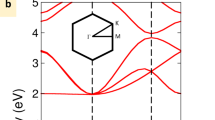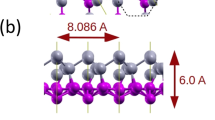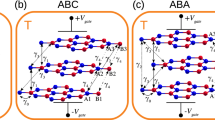Abstract
Carbon materials such as graphene are of potential use in the development of electronic devices because of properties such as high mechanical strength and electrical and thermal conductivity. However, technical challenges, including difficulties in generating and modulating bandgaps, have limited the application of such materials. Here we show that the bandgaps of bilayers of two-dimensional C3N can be engineered by controlling the stacking order or applying an electric field. AA′ stacked C3N bilayers are found to have a smaller bandgap (0.30 eV) than AB′ stacked bilayers (0.89 eV), and both bandgaps are lower than that of monolayer C3N (1.23 eV). The larger bandgap reduction observed in AA′ stacked bilayers, compared with AB′ stacked bilayers, is attributed to the greater pz-orbital overlap. By applying an electric field of ~1.4 V nm−1, a bandgap modulation of around 0.6 eV can be achieved in the AB′ structure. We also show that the C3N bilayers can offer controllable on/off ratios, high carrier mobilities and photoelectric detection capabilities.
This is a preview of subscription content, access via your institution
Access options
Access Nature and 54 other Nature Portfolio journals
Get Nature+, our best-value online-access subscription
$29.99 / 30 days
cancel any time
Subscribe to this journal
Receive 12 digital issues and online access to articles
$119.00 per year
only $9.92 per issue
Buy this article
- Purchase on Springer Link
- Instant access to full article PDF
Prices may be subject to local taxes which are calculated during checkout




Similar content being viewed by others
Data availability
The data that support the plots within this manuscript and other findings of this study are available from the corresponding authors upon reasonable request. Source data are provided with this paper.
References
Cavin, R. K., Lugli, P. & Zhirnov, V. V. Science and engineering beyond Moore’s law. Proc. IEEE 100, 1720–1749 (2012).
Keshavarzi, A. et al. Carbon nanotube field-effect transistors for high-performance digital circuits—transient analysis, parasitics and scalability. IEEE Trans. Electron Devices 53, 2718–2726 (2006).
Avouris, P., Chen, Z. & Perebeinos, V. Carbon-based electronics. Nat. Nanotechnol. 2, 605–615 (2007).
Zhang, Z. et al. Doping-free fabrication of carbon nanotube based ballistic CMOS devices and circuits. Nano Lett. 7, 3603–3607 (2007).
Hills, G. et al. Modern microprocessor built from complementary carbon nanotube transistors. Nature 572, 595–602 (2019).
Wang, X. et al. N-doping of graphene through electrothermal reactions with ammonia. Science 324, 768–771 (2009).
Britnell, L. et al. Field-effect tunneling transistor based on vertical graphene heterostructures. Science 335, 947–950 (2012).
Singh, V. et al. Graphene based materials: past, present and future. Prog. Mater. Sci. 56, 1178–1271 (2011).
Park, S., Vosguerichian, M. & Bao, Z. A review of fabrication and applications of carbon nanotube film-based flexible electronics. Nanoscale 5, 1727–1752 (2013).
Rao, R. et al. Carbon nanotubes and related nanomaterials: critical advances and challenges for synthesis toward mainstream commercial applications. ACS Nano 12, 11756–11784 (2018).
Panchakarla, L. S. et al. Synthesis, structure and properties of boron‐ and nitrogen‐doped graphene. Adv. Mater. 21, 4726–4730 (2009).
Wang, H., Maiyalagan, T. & Wang, X. Review on recent progress in nitrogen-doped graphene: synthesis, characterization and its potential applications. ACS Catal. 2, 781–794 (2012).
Liu, L., Liu, F. & Zhao, J. Curved carbon nanotubes: from unique geometries to novel properties and peculiar applications. Nano Res. 7, 626–657 (2014).
Javey, A., Guo, J., Wang, Q., Lundstrom, M. & Dai, H. Ballistic carbon nanotube field-effect transistors. Nature 424, 654–657 (2003).
Schwierz, F. Graphene transistors. Nat. Nanotechnol. 5, 487–496 (2010).
Du, X., Skachko, I., Barker, A. & Andrei, E. Y. Approaching ballistic transport in suspended graphene. Nat. Nanotechnol. 3, 491–495 (2008).
Li, Y. Y., Chen, M. X., Weinert, M. & Li, L. Direct experimental determination of onset of electron–electron interactions in gap opening of zigzag graphene nanoribbons. Nat. Commun. 5, 4311 (2014).
Wei, D. et al. Synthesis of N-doped graphene by chemical vapor deposition and its electrical properties. Nano Lett. 9, 1752–1758 (2009).
Cai, J. et al. Graphene nanoribbon heterojunctions. Nat. Nanotechnol. 9, 896–900 (2014).
Deng, Y., Xie, Y., Zou, K. & Ji, X. Review on recent advances in nitrogen-doped carbons: preparations and applications in supercapacitors. J. Mater. Chem. A 4, 1144–1173 (2016).
Mizuno, S., Fujita, M. & Nakao, K. Electronic states of graphitic heterocompounds of carbon, boron and nitrogen. Synth. Met. 71, 1869–1870 (1995).
Yang, S. et al. C3N—a 2D crystalline, hole-free, tunable-narrow-bandgap semiconductor with ferromagnetic properties. Adv. Mater. 29, 1605625 (2017).
Mahmood, J. et al. Two-dimensional polyaniline (C3N) from carbonized organic single crystals in solid state. Proc. Natl Acad. Sci. USA 113, 7414–7419 (2016).
Xu, J. et al. 2D frameworks of C2N and C3N as new anode materials for lithium-ion batteries. Adv. Mater. 29, 1702007 (2017).
Mortazavi, B. Ultra high stiffness and thermal conductivity of graphene like C3N. Carbon 118, 25–34 (2017).
Li, G. et al. Observation of van Hove singularities in twisted graphene layers. Nat. Phys. 6, 109–113 (2010).
Liu, K. et al. Evolution of interlayer coupling in twisted molybdenum disulfide bilayers. Nat. Commun. 5, 4966 (2014).
Jiang, T. et al. Valley and band structure engineering of folded MoS2 bilayers. Nat. Nanotechnol. 9, 825–829 (2014).
Zhang, Y. et al. Direct observation of a widely tunable bandgap in bilayer graphene. Nature 459, 820–823 (2009).
Wu, S. et al. Electrical tuning of valley magnetic moment through symmetry control in bilayer MoS2. Nat. Phys. 9, 149–153 (2013).
Ciarrocchi, A., Avsar, A., Ovchinnikov, D. & Kis, A. Thickness-modulated metal-to-semiconductor transformation in a transition metal dichalcogenide. Nat. Commun. 9, 919 (2018).
Li, L. et al. Direct observation of the layer-dependent electronic structure in phosphorene. Nat. Nanotechnol. 12, 21–25 (2017).
Bandurin, D. A. et al. High electron mobility, quantum Hall effect and anomalous optical response in atomically thin InSe. Nat. Nanotechnol. 12, 223–227 (2017).
Mishchenko, A. et al. Twist-controlled resonant tunnelling in graphene/boron nitride/graphene heterostructures. Nat. Nanotechnol. 9, 808–813 (2014).
Kim, K. et al. van der Waals heterostructures with high accuracy rotational alignment. Nano Lett. 16, 1989–1995 (2016).
Liao, M. et al. Twist angle-dependent conductivities across MoS2/graphene heterojunctions. Nat. Commun. 9, 4068 (2018).
Ribeiro-Palau, R. et al. Twistable electronics with dynamically rotatable heterostructures. Science 361, 690–693 (2018).
Yeh, P.-C. et al. Direct measurement of the tunable electronic structure of bilayer MoS2 by interlayer twist. Nano Lett. 16, 953–959 (2016).
Zhang, Z. et al. Flat bands in twisted bilayer transition metal dichalcogenides. Nat. Phys 16, 1093–1096 (2020).
Cao, T., Li, Z., Qiu, D. Y. & Louie, S. G. Gate switchable transport and optical anisotropy in 90° twisted bilayer black phosphorus. Nano Lett. 16, 5542–5546 (2016).
Deng, B. et al. Efficient electrical control of thin-film black phosphorus bandgap. Nat. Commun. 8, 14474 (2017).
Ramasubramaniam, A., Naveh, D. & Towe, E. Tunable band gaps in bilayer transition-metal dichalcogenides. Phys. Rev. B 84, 205325 (2011).
Chu, T., Ilatikhameneh, H., Klimeck, G., Rahman, R. & Chen, Z. Electrically tunable bandgaps in bilayer MoS2. Nano Lett. 15, 8000–8007 (2015).
Velasco, J. et al. Transport spectroscopy of symmetry-broken insulating states in bilayer graphene. Nat. Nanotechnol. 7, 156–160 (2012).
Wang, X. et al. Anisotropic carrier mobility in single-and bi-layer C3N sheets. Phys. B 537, 314–319 (2018).
Li, X., Wang, X., Zhang, L., Lee, S. & Dai, H. Chemically derived, ultrasmooth graphene nanoribbon semiconductors. Science 319, 1229–1232 (2008).
Wang, X.-P. et al. Electric field analyses on monolayer semiconductors: the example of InSe. Phys. Chem. Chem. Phys. 20, 6945–6950 (2018).
Zheng, F., Liu, Z., Wu, J., Duan, W. & Gu, B.-L. Scaling law of the giant Stark effect in boron nitride nanoribbons and nanotubes. Phys. Rev. B 78, 085423 (2008).
Zibouche, N., Philipsen, P., Kuc, A. & Heine, T. Transition-metal dichalcogenide bilayers: switching materials for spintronic and valleytronic applications. Phys. Rev. B 90, 125440 (2014).
Oostinga, J. B., Heersche, H. B., Liu, X., Morpurgo, A. F. & Vandersypen, L. M. K. Gate-induced insulating state in bilayer graphene devices. Nat. Mater. 7, 151–157 (2008).
Bhattacharya, B., Tomar, S. K., Saxena, A., Lee, J. Y. & Park, J.-K. Ageing and temperature‐dependent behaviour of CdS nanoparticles. Phys. Status Solidi B 246, 832–836 (2009).
Liu, J. et al. Metal-free efficient photocatalyst for stable visible water splitting via a two-electron pathway. Science 347, 970–974 (2015).
Kresse, G. & Furthmüller, J. Efficiency of ab-initio total energy calculations for metals and semiconductors using a plane-wave basis set. Comput. Mater. Sci. 6, 15–50 (1996).
Perdew, J. P., Burke, K. & Ernzerhof, M. Generalized gradient approximation made simple. Phys. Rev. Lett. 77, 3865–3868 (1996).
Grimme, S. Semiempirical GGA‐type density functional constructed with a long‐range dispersion correction. J. Comput. Chem. 27, 1787–1799 (2006).
Heyd, J., Scuseria, G. E. & Ernzerhof, M. Hybrid functionals based on a screened Coulomb potential. J. Chem. Phys. 118, 8207–8215 (2003).
Shishkin, M. & Kresse, G. Self-consistent GW calculations for semiconductors and insulators. Phys. Rev. B 75, 235102 (2007).
Shishkin, M. & Kresse, G. Implementation and performance of the frequency-dependent GW method within the PAW framework. Phys. Rev. B 74, 035101 (2006).
Monkhorst, H. J. & Pack, J. D. Special points for Brillouin-zone integrations. Phys. Rev. B 13, 5188–5192 (1976).
Acknowledgements
This work was financially supported by the National Natural Science Foundation of China (grants 21673075, 51725204, 21771132, 51972216, 52041202, 11774368, 11804353, 11704204, 61971035, 61901038 and 61725107), National Key Research and Development Program of China (2019YFA0308000, 2020YFA0308800 and 2020YFA0406104), Innovative Research Group Project of the National Natural Science Foundation of China (51821002), the Australian Research Council through the Discovery Early Career Research Program (DE170101403), Natural Science Foundation of Jiangsu Province (BK20190041), Key-Area Research and Development Program of GuangDong Province (2019B010933001), Collaborative Innovation Center of Suzhou Nano Science & Technology, the Priority Academic Program Development of Jiangsu Higher Education Institutions (PAPD) and the 111 Project. B.I.Y. thanks the Office of Naval Research (N00014−18-1-2182) and the Army Research Office (W911NF-16-1-0255) for support. W.W. was supported by a scholarship from the China Scholarship Council. The computations were performed at ECNU Multifunctional Platform for Innovation (001), Shanghai Supercomputer Center and using computational resources of the NCI through the National Computational Merit Allocation Scheme supported by the Australian Government, the Queensland Cyber Infrastructure Foundation and the University of Queensland Research Computing Centre. We thank D. Sun in East China Normal University for useful discussions.
Author information
Authors and Affiliations
Contributions
Q.Y. and D.J.S. conceived and supervised the theoretical calculations for the work. Z.K., Y.W. and G.D. supervised the experimental part of the project. W.W., W.P., Z.C. and L.W. carried out the theoretical calculations. S.Y., Y.Y. and P.H. synthesized monolayer and bilayer C3N. S.Y., Y.Y. and G.W. characterized the monolayer and bilayer C3N. S.Y., G.W. and L.Z. fabricated C3N devices and analysed experimental data. T.Z., L.L., Q.Z. and Y.W. conducted the scanning tunnelling spectroscopy/scanning tunnelling microscopy measurements. A.B. and B.I.Y. analysed the data and discussed the manuscript. Q.Y., W.W., S.Y. and D.J.S. wrote and revised the manuscript.
Corresponding authors
Ethics declarations
Competing interests
The authors declare no competing interests.
Additional information
Peer review information Nature Electronics thanks the anonymous reviewers for their contribution to the peer review of this work.
Publisher’s note Springer Nature remains neutral with regard to jurisdictional claims in published maps and institutional affiliations.
Supplementary information
Supplementary Information
Supplementary Figs. 1–26, Discussion and Tables 1–4.
Source data
Source Data Fig. 1
Source data for Fig. 1a,c.
Source Data Fig. 2
Source data for Fig. 2a.
Source Data Fig. 3
Source data for Fig. 3g,j,n.
Source Data Fig. 4
Source data for Fig. 4b–d.
Rights and permissions
About this article
Cite this article
Wei, W., Yang, S., Wang, G. et al. Bandgap engineering of two-dimensional C3N bilayers. Nat Electron 4, 486–494 (2021). https://doi.org/10.1038/s41928-021-00602-z
Received:
Accepted:
Published:
Issue Date:
DOI: https://doi.org/10.1038/s41928-021-00602-z
This article is cited by
-
Electronic and optical properties of P-substituted tellurene nanoribbons: first principles study
Journal of Nanoparticle Research (2022)



